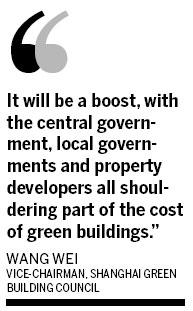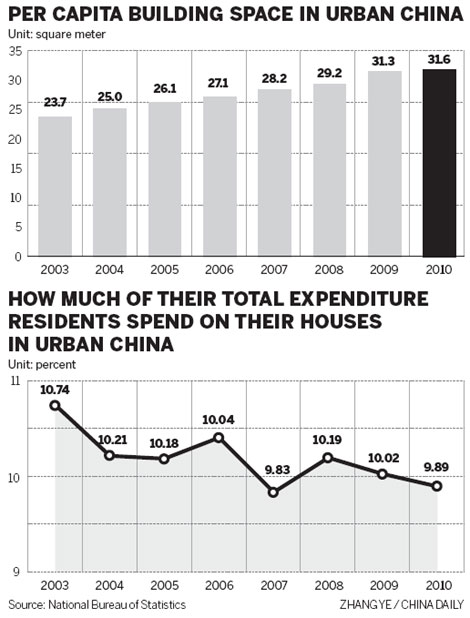The cost of creating a greener future
By Xie Yu in Shanghai (China Daily) Updated: 2012-06-25 09:47
|
 |
|
A developer promotes its commercial residential property with a slogan stating its low-carbon lifestyle in Beijing. Both domestic and foreign companies are targeting China's green property development market. [Photo/China Daily] |
According to an evaluation standard for green buildings released by the ministries, green buildings require construction projects to save as much energy, land, water and materials as possible throughout their life cycle to protect the environment and reduce pollution.
Analysts said the move indicates that the green construction sector will be an economic breakthrough in terms of spurring growth and play a large role in the country's energy-saving efforts.
Green buildings will receive subsidies of 45 yuan to 80 yuan a sq m, according to the new policy.
"The subsidy means so much to the industry. It will be a boost, with the central government, local governments and property developers all shouldering part of the cost of green buildings. And green buildings will repay their cost during their life cycles," said Wang Wei, vice-chairman of Shanghai Green Building Council.
Zhang Shaochun, deputy minister at the Ministry of Finance, said the new policy will leverage a green market with trillions of yuan because developing green buildings will effectively drive the growth of new building materials, new energy and related service sectors, Xinhua News Agency reported.
"It is a great opportunity for Landsea because we are committed to building green homes, which we believe is the direction for real estate development in the future. We have been a leader in concepts and technology in this respect," said Du Zijian, senior planning manager at sLandsea.
It is not only Chinese companies that are targeting this market.
Bayer MaterialScience, a leading global material manufacturer, is constructing a zero-emission building in East China's Qingdao city in Shandong province.
Buildings are responsible for 40 percent of energy use and almost one third of greenhouse gas emissions worldwide. China has an ambitious target to meet in terms of reducing carbon dioxide emissions and energy consumption. "We want to demonstrate sustainable buildings can help the country reach the target being set by the 12th Five-Year Plan and that solutions are locally available," said Michael Voigt, head of the eco-commercial building program for China at Bayer.

"China is a really important market for Bayer MaterialScience. We are expecting more and more demand for high-performance materials and solutions in the construction industry," Voigt added. His company is joining China's real estate company China Vanke Co in developing a green building park in Fangshan district, Beiijing.
However, Voigt pointed out that the construction cost is comparatively higher for building eco-commercial buildings and the Chinese real estate industry "currently realizes its business value primarily from sales rather than from the quality achievements of buildings".
In the value chain of construction, especially in China, there is a situation that the occupier, the party that has to face the high operational costs borne by the structure, is mostly disconnected from building layout decisions, he added.
In order to recognize a sustainable building's full economic potential, its complete life cycle needs to be assessed, in which the saved energy and resources should be calculated, Voigt said.
The actual operation of green buildings is crucial. Energy efficiency cannot only be achieved through design but should be calculated and assessed during the life of the building, said Wang.
"Problems of operation exist widely in China's green buildings. In fact, only few of them reach the official standards after a year's operation," he added.
xieyu@chinadaily.com.cn

- China's foreign service trade deficit rises
- Firm behind Three Gorges Dam reports surging overseas deals
- Chinese entrepreneurs remain optimistic despite economic downfall
- New Zealand eyes more investment from China
- Robotic exhibition set to kick off in Shenyang
- Chrysler announces more China recalls
- Geely performance hits 5-year high
- BAIC sets up US research center

















